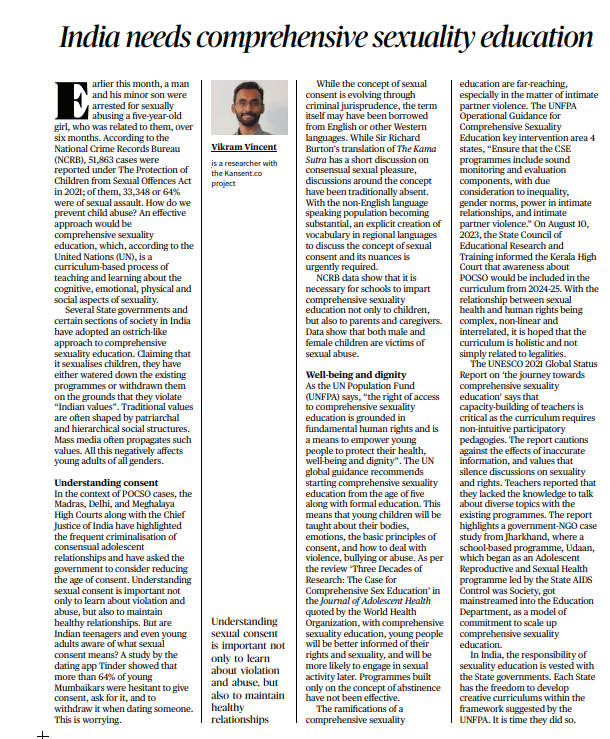THE G-20'S ROLE IN DRIVING JUST AND INCLUSIVE ENERGY TRANSITIONS: KEY ACTIONS FOR CLIMATE LEADERSHIP
Introduction
- The G-20, comprising the world’s major economies, holds significant responsibility for greenhouse gas emissions and fossil fuel production.
- While many members have pledged to achieve net-zero emissions, their commitments need to be translated into collective climate action.
- The upcoming G-20 summit in New Delhi presents a critical opportunity to demonstrate leadership and unity on climate goals.
Shifting Toward Clean Energy
➼ Renewable Energy Progress: G-20 members have shown some commitment to transitioning to clean energy, with renewables contributing 29% of their energy mix in 2021, up from 19% in 2010.
➼ India’s Renewable Energy Advances: India, for instance, has made substantial strides, becoming the world’s third-largest producer of renewable energy.
➼ It aims to further expand renewables to constitute 50% of energy production by 2030.
➼ Demand, Carbon Budget, and Urgency: The urgency of addressing climate change demands more significant shifts in energy sources, especially as global carbon budgets deplete faster than anticipated.
Action Areas for Climate Leadership
- Enhancing Governance Structures
- Inclusive Energy Transitions: G-20 nations must improve governance processes for just energy transitions, ensuring inclusivity and equitable outcomes. They should establish clear governance structures that promote coherence and attract investments.
- Expanded Progress Indicators: Progress metrics should extend beyond traditional measures like job creation and economic growth. They should encompass job quality, accessibility, community resilience, and innovation.
- Collaborative Approaches: Countries could form multi-ministerial task forces or joint working groups to coordinate transition efforts, inspired by models like South Africa’s Presidential Climate Commission.
Facilitating Decarbonization
- Economic Diversification: G-20 should view the energy transition as an opportunity to diversify economies, ensuring stability, livelihoods, and revenue streams.
- Role of Financial Institutions: International financial institutions need to align investments with renewable energy and energy efficiency projects, including low-carbon industrial technologies.
- Green Steel Transition: G-20, with its significant steel production and consumption, can drive global low-carbon steel production through mandates for international financial institutions and collective commitment to Green Public Procurement.
Promoting Transparency and Accountability
- Streamlining International Efforts: G-20 should take the lead in harmonizing global just energy transition initiatives, facilitated by enhanced transparency and accountability.
- Disclosure Mechanisms: Establishing disclosure mechanisms for energy transition data through existing mechanisms like the G-20 Energy Transitions and Sustainable Finance Working Groups and Just Energy Transition Partnerships (JET-Ps).
- Encouraging Fossil-Fuel Producing Countries: G-20 can urge fossil-fuel producing nations to share transparent information about their oil, gas, and coal projects in alignment with climate goals.
Conclusion: Collective Action for a Sustainable Future
The G-20’s New Delhi summit provides an indispensable platform for Heads of State and Government to endorse a robust leader’s declaration, emphasizing collective ambition to combat climate change.
As the devastating consequences of climate change become increasingly evident, there is an urgent need for decisive and collaborative action. The G-20 can pave the way for a just and inclusive transition, ensuring a shared victory in the race toward a sustainable future.
PROMOTING COMPREHENSIVE SEXUALITY EDUCATION FOR PREVENTING CHILD ABUSE AND EMPOWERING YOUTH
Introduction: Child Abuse and Sexual Offences
- Earlier this month, a distressing case of a man and his minor son being arrested for sexually abusing a five-year-old girl, who was a relative, brought attention to the pervasive issue of child abuse.
- The National Crime Records Bureau (NCRB) reported 51,863 cases under The Protection of Children from Sexual Offences Act (POCSO) in 2021, with 64% being cases of sexual assault.
- To address this alarming trend, effective prevention strategies, including comprehensive sexuality education, are vital.
Comprehensive Sexuality Education as a Solution
- Comprehensive sexuality education, a curriculum-based approach endorsed by the United Nations (UN), is a promising strategy for preventing child abuse.
- It encompasses teaching about cognitive, emotional, physical, and social aspects of sexuality.
- However, certain segments of Indian society and state governments have resisted this approach, citing concerns of sexualizing children and violating traditional values.
- This opposition is often linked to deeply ingrained patriarchal and hierarchical structures perpetuated by mass media.
Understanding Consent: Bridging Knowledge Gap
- An important component of comprehensive sexuality education is educating young individuals about sexual consent.
- The Madras, Delhi, and Meghalaya High Courts, along with the Chief Justice of India, have raised concerns about the criminalization of consensual adolescent relationships and advocated for revisiting the age of consent.
- The concept of sexual consent might be borrowed from Western languages, and efforts to create vocabulary in regional languages are necessary to ensure understanding among diverse populations.
The Need for Inclusive Education
- NCRB data highlights the importance of comprehensive sexuality education not only for children but also for parents and caregivers.
- Both male and female children are victims of sexual abuse, making it crucial to equip them with the knowledge and skills to protect themselves.
- The UNFPA emphasizes that comprehensive sexuality education is a fundamental human right that empowers young people to safeguard their well-being and dignity.
Early Start and Holistic Approach
- UN global guidance advocates starting comprehensive sexuality education as early as age five, alongside formal education.
- This early education covers topics such as understanding one’s body, emotions, consent, and dealing with violence.
- Such education helps young individuals become informed about their rights and sexuality, leading to healthier decisions later in life.
- Programs centered solely around abstinence have proven ineffective in achieving these goals.
Comprehensive Sexuality Education and Intimate Partner Violence
- Comprehensive sexuality education has far-reaching implications, particularly concerning intimate partner violence.
- The UNFPA operational guidance highlights the importance of integrating discussions on inequality, gender norms, power dynamics in relationships, and intimate partner violence within these programs.
- Kerala’s initiative to include awareness about POCSO in its curriculum reflects a step towards holistic education.
Challenges and Opportunities
- The UNESCO 2021 Global Status Report emphasizes the critical role of teachers in delivering comprehensive sexuality education.
- Capacity-building for teachers is essential due to the participatory nature of the curriculum.
- The report acknowledges the dangers of inaccurate information and value systems that discourage open conversations about sexuality and rights.
- It also highlights a successful case study from Jharkhand, where a government-NGO partnership led to the mainstreaming of a comprehensive sexuality education program.
State Governments’ Responsibility
- In India, the responsibility for sexuality education lies with state governments.
- Each state has the freedom to develop creative curricula within the framework suggested by the UNFPA.
- It is imperative for state governments to take proactive steps in implementing comprehensive sexuality education to address child abuse, promote healthy relationships, and empower youth.
Conclusion
Comprehensive sexuality education emerges as a promising approach to prevent child abuse, empower young people, and promote healthy relationships.
By overcoming societal resistance, providing accurate information, and fostering open discussions, India can take significant strides toward ensuring the well-being and dignity of its future generations.
INDIA'S AIR POWER STRATEGY AND ITS ROLE IN GEOPOLITICS
Introduction: India’s Rising Great Power Ambitions
- India’s burgeoning economic growth and growing international prominence have propelled its aspirations for great power status.
- As India garners respect and attention on the global stage, it is increasingly expected to assume greater responsibilities in world affairs.
Shift in Air Power Perspective: National Security Beyond Traditional Domains
- India’s historical underutilization of air power, despite its significant role in past conflicts, is undergoing a transformative shift.
- The notion of national security is evolving from a land and maritime-centric perspective to a future-oriented, multi-domain approach.
- The Indian Air Force’s (IAF) increased involvement in international exercises reflects the acknowledgment of air power’s significance in national security.
China’s Air Power Strategies: Impetus for India’s Air Power Focus
- China’s assertive foreign policy and revisionist strategies, demonstrated through its air force activities in the Taiwan Strait and East/South China Seas, highlight the importance of air power in modern geopolitics.
- China’s recognition of India’s advantage in asymmetric air power during regional crises has led to the bolstering of its own air power infrastructure in the Tibet Autonomous Region.
IAF’s Role in Border Talks: Potential for Expanded Air Power Use
- The inclusion of the IAF in border discussions with the Indian Army signifies a crucial development.
- Given the growing capabilities of the People’s Liberation Army Air Force (PLAAF), India may soon deploy air power for political signaling and coercion in disputed airspaces.
- Additionally, leveraging air power in the Indian Ocean, a vital trade and security region, becomes imperative.
Enhancing Military Power: The Rafale Deal and Strategic Interoperability
- India’s approval of procuring maritime variants of the Rafale combat aircraft highlights two critical aspects:
- the importance of air power in maritime contexts and the need to enhance interoperability between land-based IAF and
- carrier-based Navy air power.
- The influence of the US’s aircraft carrier strategy on China’s coercive diplomacy is noteworthy, particularly in safeguarding economic interests and asserting influence.
Air Power and Maritime Geopolitics: India’s Unique Advantage
- The China-Pakistan Economic Corridor’s access to the Arabian Sea and the China-Myanmar Economic Corridor’s opening into the Bay of Bengal offer China vital maritime routes, while also challenging India’s security.
- India, with its dominance in airspaces over these strategic maritime spaces, possesses a distinct advantage.
- This capability strengthens India’s security, regional presence, and geopolitical standing.
Leveraging Air Power: Benefits and Strategic Options
- Leveraging air power offers numerous advantages. It enables India to establish a robust hard power deterrence in the South China Sea, ensuring freedom of navigation and airspace in the Indian Ocean.
- Additionally, India’s air power capabilities facilitate access to strategically positioned air bases in friendly nations, enhancing regional influence.
- Moreover, air power allows India to exercise soft power through humanitarian aid and disaster relief.
Conclusion: Air Power as a Cornerstone of India’s Geopolitical Strategy
India’s recognition of air power’s role in national and regional security, coupled with its growing international engagement, underscores the evolving significance of this domain in the country’s geopolitical strategy.
As India navigates complex border issues with China and seeks to assert itself in the Indo-Pacific, air power emerges as a pivotal tool to secure its interests, strengthen regional ties, and solidify its position on the global stage.




